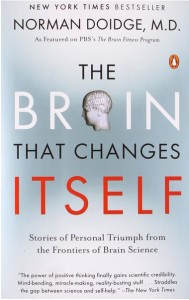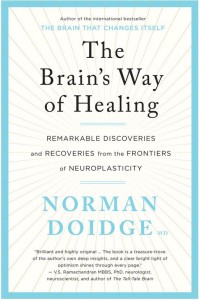 The Brain that Changes Itself: Stories of Personal Triumph from the Frontiers of Brain Science by Norman Doidge; Penguin Books; 2007.
The Brain that Changes Itself: Stories of Personal Triumph from the Frontiers of Brain Science by Norman Doidge; Penguin Books; 2007.
The Brain’s Way of Healing: Remarkable Discoveries and Recoveries from the Frontiers of Neuroplasticity by Norman Doidge; Viking Penguin Books; 2015.
Can we change our brains? Canadian psychiatrist and bestselling author Norman Doidge thinks we can.
Doidge has written two books about the amazing malleability of the brain. His latest book goes one step further and explores the treatment of brain injuries and illnesses through neuroplastic healing. According to Doidge, many conditions previously thought to be pretty much untreatable, such as MS and dementia, can be greatly improved and sometimes healed through techniques such as intense exercise, visualization, singing, tongue exercises or low level laser therapy.
Doidge explains:
“The common wisdom was that after childhood the brain changed only when it began the long process of decline; that when brain cells failed to develop properly, or were injured, or died, they could not be replaced. Nor could the brain ever alter its structure and find a new way to function if part of it was damaged. The theory of the unchanging brain decreed that people who were born with brain or mental limitations, or who sustained brain damage, would be limited or damaged for life.” 1
In fact, according to Doidge’s read on recent research, the reality is quite the opposite. He quotes the claims of one of the leading researchers on brain plasticity, Michael Merzenich, who is a professor emeritus neuroscientist at the University of California: that brain exercises may be as useful as drugs to treat diseases as severe as schizophrenia; that plasticity exists from the cradle to the grave; and that radical improvements in cognitive functioning – what we learn, think, perceive and remember – are possible even in the elderly.2
According to Doidge’s books, we should not be surprised that when we spend time practicing to hone our skills and shape our behaviors, we affect not only our muscles and joints, but also our nerves and brain cells as well.
Both books are as hopeful as they are divisive. Some will find the first book somewhat optimistic but untested; the second book even more so. Both are a light read for some, while others will think them too dense and scientific. In my view, both books walk the right line between both extremes, presenting engaging stories and just enough scientific background to back up most claims without becoming pedantic and boring.
 As I mentioned, the second book goes farther than the first, though it does bounce around a bit. Included are a number of loosely connected chapters about innovative treatments that have brought remarkable results for conditions ranging from chronic pain to Parkinson’s, blindness to dyslexia. It promotes the efficacy of a wide variety of methods, which in every case draw upon our brain’s remarkable adaptability and applications of neuroplasticity.
As I mentioned, the second book goes farther than the first, though it does bounce around a bit. Included are a number of loosely connected chapters about innovative treatments that have brought remarkable results for conditions ranging from chronic pain to Parkinson’s, blindness to dyslexia. It promotes the efficacy of a wide variety of methods, which in every case draw upon our brain’s remarkable adaptability and applications of neuroplasticity.
Personally, I like knowing about new methods in the science of health, even if they are presented somewhat chaotically and are somewhat unorthodox in style. Some readers might conclude that a number of these innovative therapies are quackery, while others will be overjoyed that such new methods exist – and will be impatient to benefit from them, dismayed that they are not widely available. After all, if you have dementia, or simply worry about it, as most of us in the second-half of life do, rare books like these can at least give us hope that something good is being researched, and might possibly result in methods we can employ for ourselves or our loved ones.
For anyone the least bit inclined to believe these treatments might work, Doidge challenges us to accept there is much about the brain that we currently do not understand. In fact, I was reminded by reading these books that there is something awesome about the way we are made and the One who made us, which is something to celebrate.
It also occurred to me that Jesus was constantly challenging people, too. He questioned their assumptions and turned them inside out, uttering paradoxes and telling mysterious open-ended parables.
If nothing else, these books provide a long overdue way of catching up our thinking about thinking, alerting us to a few methods that have been used with some success for many decades, and in some cases, centuries. More than that, they challenge us to seriously consider our untapped potential. The second book dares to propose that we have in-built powers to heal.
Why this area of research seems to challenge orthodox medical practitioners may be precisely because it stretches our brains, as well as our paradigms, about healthcare. Perhaps we all need to take a good look at our assumptions, to take a fresh look at the way we perceive, to be open to a new revolution in the way we think.
- Norman Doidge; The Brain that Changes Itself (New York, Penguin Books, 2007) pg. xvii
- Doige, pg. 46








Doige has also written over 170 articles.
Most notably a very popular article in Maclean’s magazine a few years back.